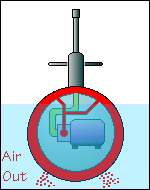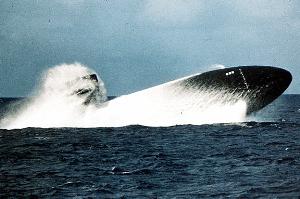 When the blower begins to build up pressure, the water is forced out the grates in the bottom of the ballast tanks. As more water is removed, the ship becomes lighter until the force of gravity is overcome by the force of bouyancy and the submarine begins to rise to the surface. Obviously if the main ballast tank vent valves were open, the air would escape out the top and the ship would be unable to empty its ballast tanks and surface. This is the reason the MBT vents are shut when the ship is submerged. In an emergency, high pressure air can be suddenly forced into the tanks to cause a rapid dewatering of the ballast tanks, and the ship will surface.
When the blower begins to build up pressure, the water is forced out the grates in the bottom of the ballast tanks. As more water is removed, the ship becomes lighter until the force of gravity is overcome by the force of bouyancy and the submarine begins to rise to the surface. Obviously if the main ballast tank vent valves were open, the air would escape out the top and the ship would be unable to empty its ballast tanks and surface. This is the reason the MBT vents are shut when the ship is submerged. In an emergency, high pressure air can be suddenly forced into the tanks to cause a rapid dewatering of the ballast tanks, and the ship will surface.
